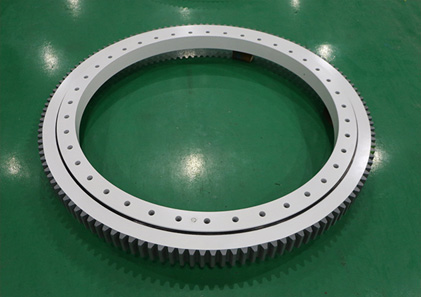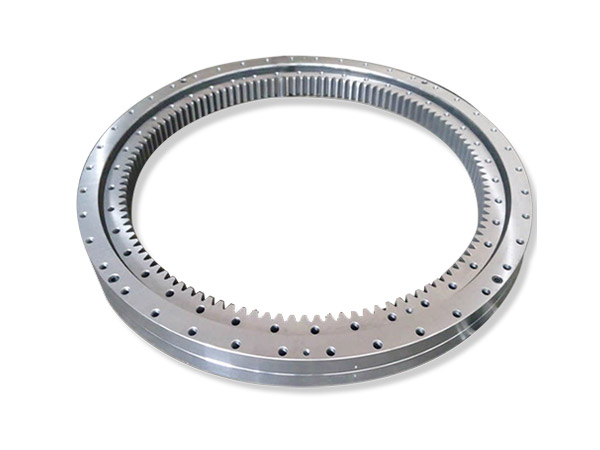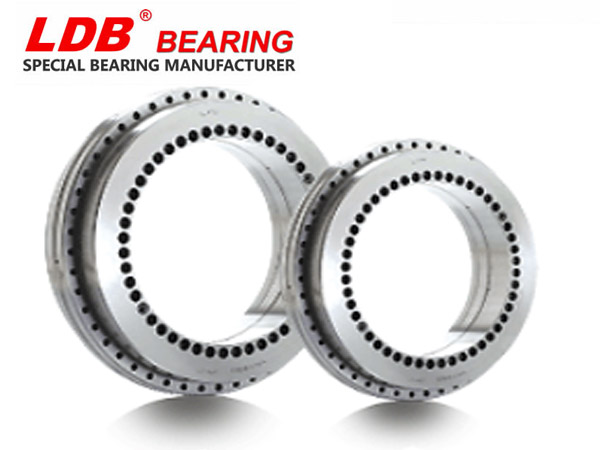¿Cómo distinguir la autenticidad de un rodamiento giratorio de su apariencia?
Los productos falsificados son una existencia odiosa para todos los ámbitos de la vida. Muchos productos falsos e inferiores llevan el mismo embalaje exterior que la marca normal, pero se encuentran entre los fallos de Jinyu. No solo no se puede garantizar la calidad del producto, sino que incluso puede estar en uso. Durante el proceso, el mantenimiento y la parada de la máquina provocaron pérdidas económicas impredecibles. Entonces, ¿cómo deberíamos distinguir lo verdadero y lo falso del anillo giratorio de la apariencia cuando compramos el anillo giratorio todos los días? El editor está aquí hoy.
Primero, ocho métodos falsificados de anillo giratorio

1. Fraude material: utilice hierro o acero al carbono para fabricar cojinetes giratorios o reparar cojinetes de desecho. El primero causará una dureza insuficiente del rodamiento y el segundo causará una precisión del rodamiento insuficiente. Una vez que estos cojinetes giratorios se utilizan en cojinetes que requieren alta precisión y dureza, pueden causar fácilmente fallas en la máquina.
2. Embalaje exterior falsificado: Marque el anillo de giro o rodamiento inferior producido por una pequeña fábrica con la marca comercial de un gran fabricante, y falsifique el embalaje interior y exterior y el certificado de conformidad del producto de marca grande. De esta forma, puede utilizar la influencia de marca de los principales fabricantes para ampliar las ventas de sus productos.
3. Canales de venta falsificados: usuarios, distribuidores, agentes o incluso puntos de venta al contado de fabricantes falsificados de marcas conocidas. Dejemos que los consumidores no puedan juzgar lo verdadero y lo falso y emitan juicios erróneos.
4. Finge ser inferior: usa cojinetes inferiores como cojinetes. En el proceso de producción de cojinetes, los productos defectuosos se producirán más o menos y, por lo general, se desecharán. Algunas empresas de corazón negro pretenderán ser productos defectuosos a la venta, pero la calidad de los productos es difícil de garantizar.
5. Fraude de precisión: utilice rodamientos ordinarios para simular que son rodamientos de alta precisión. Los rodamientos de precisión tienen diferentes requisitos para la precisión de varias piezas durante la producción. En comparación con los rodamientos ordinarios, los requisitos se relajarán. De esta manera, el medio común de hacerse pasar por cojinetes giratorios de precisión también es muy aborrecible.
6. Venta de productos falsificados: los rodamientos giratorios se suelen comprar en grandes cantidades cuando se venden. Algunos comerciantes se aprovechan de la mentalidad del comprador de que no comprobarán uno por uno y los venderán junto con productos falsificados, y la calidad del producto variará. Hay una mala situación.
7. Fraude de precios: para aumentar las ganancias, las empresas venden productos falsificados a precios elevados y utilizan precios falsos.
8. Fíjese en las personas para entregar las mercancías: al vender rodamientos giratorios, los comerciantes proporcionarán suministros selectivos de acuerdo con las condiciones específicas del vendedor. Si los compradores quieren productos baratos, darán productos falsos. Si quieren buena calidad, darán productos genuinos. No sé cómo hacerlo. Aquellos que solo regatean piensan que se están aprovechando de ello, pero no saben que pueden comprar falsificaciones.
En segundo lugar, el método para identificar lo verdadero y lo falso a partir de la apariencia del anillo giratorio.

1. Mira la claridad del sello
¿Cómo distinguir la autenticidad de un rodamiento giratorio de su apariencia? Cada producto de rodamiento tendrá su nombre de marca, etiqueta, etc. impresos en el cuerpo del producto de rodamiento. Aunque las fuentes son muy pequeñas, los productos producidos por los fabricantes habituales se imprimen con tecnología de estampado de acero y se prensan antes del tratamiento térmico. Por lo tanto, aunque las fuentes son pequeñas, están profundamente empotradas y son muy claras. Normalmente, las fuentes de los productos falsificados no solo están borrosas. Debido a la tecnología de impresión aproximada, las fuentes flotan en la superficie, y algunas de ellas incluso pueden borrarse fácilmente a mano o tener trazos manuales serios.
2. Escuche el ruido dentro del rodamiento.
Sostenga el manguito interior del rodamiento con la mano izquierda y gire el manguito exterior con la mano derecha para que gire ligeramente. Escuche el ruido durante el funcionamiento del rodamiento. Debido a las condiciones de producción atrasadas de la mayoría de los productos falsificados y la operación de taller puramente hecha a mano, el cuerpo del rodamiento inevitablemente se mezclará con impurezas como polvo y arena durante el proceso de producción. Por lo tanto, pueden producirse ruidos o un funcionamiento irregular cuando el rodamiento gira. fenómeno. Esta es la clave para juzgar si el producto proviene de la marca de un fabricante regular que tiene estándares de producción estrictos y es operado por una máquina.
3. Vea si la superficie está limpia
Si hay manchas de aceite turbio en la superficie, debemos prestarle especial atención al comprar rodamientos importados. Dado que todavía existe una cierta brecha entre la tecnología antioxidante nacional y los países de fabricación avanzados extranjeros, es fácil dejar marcas de aceite gruesas cuando se realiza un tratamiento antioxidante en el cuerpo del rodamiento, que se siente pegajoso y pegajoso cuando se toca con la mano, mientras que el original es extranjero. Casi no hay rastro de aceite antioxidante en los rodamientos importados. Según los expertos de la industria, las personas especialmente cuidadosas pueden oler un olor especial en los rodamientos importados, que es el olor a aceite antioxidante.

4. Mira el chaflán
El hecho de que se produzca el chaflán del anillo giratorio también está estrechamente relacionado con el nivel de tecnología de producción del fabricante del rodamiento. Por lo tanto, el grado ordenado del chaflán puede juzgar el nivel tecnológico del rodamiento. El llamado chaflán del rodamiento es la unión del plano horizontal y el plano vertical. Debido a la limitación de la tecnología de producción, los productos de rodamientos falsificados no se manipulan satisfactoriamente en estas esquinas, que podemos distinguir fácilmente.
5. Mira el embalaje del rodamiento.
El embalaje se divide en embalaje interior y embalaje exterior. Una vez que los rodamientos se fabrican y pasan la inspección, se limpiarán y se tratarán contra la oxidación, y luego se colocarán en el empaque interno para lograr impermeabilidad, humedad, polvo, golpes y mantener la calidad y precisión de el rodamiento y la finalidad de facilitar su uso y venta.
El embalaje interior del rodamiento se divide en tres categorías según el período antioxidante:
(1) Embalaje de período anti-óxido corto: El período anti-óxido es de 3 a 6 meses, que es adecuado para rodamientos que se envían al mismo suscriptor en grandes cantidades y se ponen en uso en un período corto de tiempo. Las dos partes han acordado utilizar envases sencillos basados en el principio de facilidad de uso.
(2) Embalaje de período antioxidante general: período antioxidante de un año, adecuado para cojinetes de uso general.
(3) Embalaje de larga duración anti-óxido: dos años anti-óxido, apto para rodamientos especiales y de precisión.
Los materiales de embalaje interior del rodamiento incluyen tubo de plástico de polietileno (caja), papel kraft, papel compuesto de polietileno liso y arrugado, caja de papel, película de plástico de polietileno o polietileno, cinta de sujeción de nailon o cinta de sujeción tejida de plástico, cinta de plástico impermeable de alta resistencia, Bolsas de arpillera, etc. Todos los materiales anteriores deben garantizar que la prueba de resistencia a la corrosión del material esté calificada.
La forma de distinguir lo verdadero y lo falso del anillo giratorio de la apariencia se puede juzgar a partir de los aspectos anteriores. Además, puede juzgar el rango de precios aproximado basándose en la comprensión del rodamiento y la situación del mercado del rodamiento. Siempre que no sea codicioso y regatee excesivamente, también puede confirmar el lugar de compra. Es difícil distinguir las fuentes verdaderas de las falsas a través de fuentes informales, y básicamente se pueden comprar rodamientos. Los cojinetes de giro producidos por nuestro Kuoyi Longda Bearing Co., Ltd. son todos productos calificados que han pasado las inspecciones de calidad. Si tiene alguna necesidad, no dude en consultarnos.






